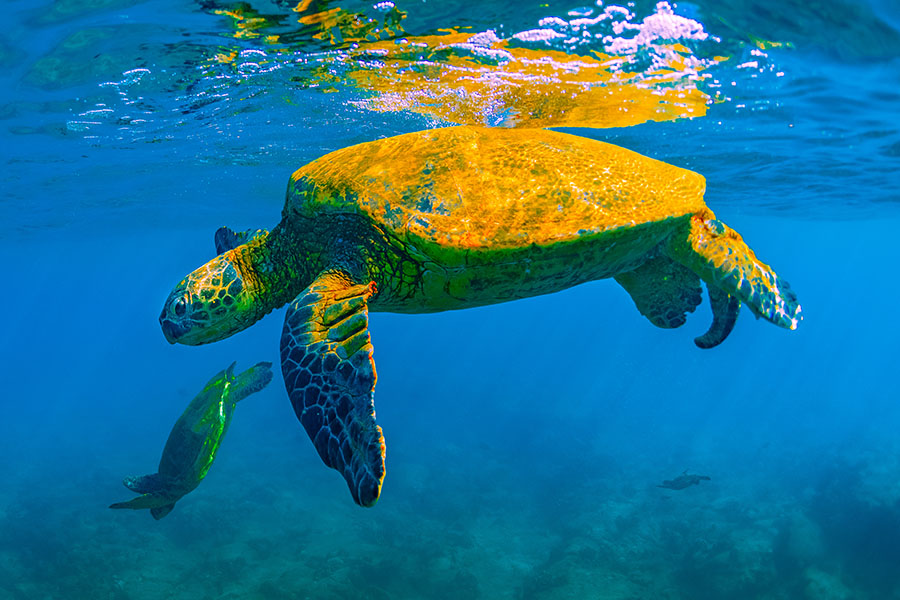Kalaheo

The leeward side of the Kauai extends from the west end of the island into the south shores, turning directions in the middle of the town of Kalaheo. The west facing side of Kalaheo overlooks the coffee fields of Wahiawa with the island of Niihau in the distance. As a plateau, the south side of Kauai has a true mountain to the sea distinction. The mountain region includes Kalaheo, Lawai, and Omao; these areas serve the agricultural communities with vast pastures and rural homes scattered throughout. In the late 1800s, Asian immigrants who came to Kauai recognized Lawai valley as a healing site. They built both Taoist and Shinto temples here and constructed 88 miniature Shingon shrines along a path that snakes up the steep hillside. They did this to replicate an ancient pilgrimage route in Shikoku Japan. Near the shrine is Lawai Bay and the National Tropical Botanical Garden. Within the garden, a tall hill protrudes from the sand at Lawai beach. This hill is a pu'u kilo i'a, a fish-spotters hill. North of the pu‘u kilo i‘a are the remains of a walled fishpond. Further inland in the valley were irrigated taro lo‘i, and Lawai Bay itself served as a sea fishery. The area is adorned with tropical rainforests that house rare and endangered species; the ecosystem is a testament to the delicate balance of nature within south kauai attractions.
Koloa
The shoreline portion of the southside includes the towns of Koloa, Kukui'ula, Poipu, and Mahaulepu. The village of Kukui'ula begins where Lawai valley ends, overlooking Lawai beach, now often referred to as Allerton's. Kukui'ula's Hawaiian placename meaning comes from the three kukui (candlenut) lava-rock bowls that were placed in the area. One was at Kukui'ula harbor and another on a mountain near Kalaheo to guide Hawaiian voyagers to Tahiti and back, as well as fishermen back to Kukui'ula harbor. There was a guiding light that once overlooked the Kukui‘ula cove, while another was at Kukuiolono, "Light of Lono," up the road in Kalaheo. The third signal fire is thought to have been located somewhere closer to the shoreline. The land holds a deep significance for the native Hawaiian people who have inhabited theses shore for centuries.

As the home of Hawai‘i's first successful sugar mill, Koloa is where it all began. The historic buildings and sites are part of the Koloa heritage trail, or Ka Ala Hele Waiwai Ho‘oilina o Koloa, a 10-mile trail that includes more than a dozen sites and monuments significant to the birth of the sugar-plantation era in Hawai‘i. Another significant trail is Hapa trail; it traverses 1.5 miles in each way through the unique historic Koloa field system down to the coast and was constructed over 150 years ago. The area on either side of Hapa trail was intensely cultivated and highly productive, flourishing with sugar cane, kalo and sweet potatoes. Today, there are only remnants of the old Koloa sugar mill structure that changed Hawaii forever. Every year, people come from near and far to celebrate this old town at the Koloa Plantation Days, which usually occurs in the summer months. This delightful event transports us back to a bygone era when sugar reigned supreme, and the air was thick with the smell of molasses. Captivating parades march through the town, adorned with vibrant floats and traditional flowers, with hula dancers dancing to the ukulele music. All the local ranchers wear their cowboy attire on horseback, while businesses and people come together to celebrate their love for this extraordinary place. This town offers shops and eateries with a variety of food to choose from, making sure that you feel like you don't have to leave this beloved south kauai attraction.
Poipu

The Poipu coast is made up of a remarkable mixture of stunning landscapes, captivating historic sites, condominiums, and beach front homes. The beaches of this gem of south kauai attractions begin at the sandy shores of Kiahuna beach and continue east through Waiohai beach, Poipu beach, and the little cove Brennecke's beach. After Brennecke's beach, the shoreline is rocky again until Keoneloa beach, today called "Shipwrecks." Swimming, sunbathing, surfing, snorkeling, bodysurfing, and boating are all part of the daily life in Poipu. With its rich history and diverse ecosystem, the Poipu coast offers visitors and locals unforgettable experiences that combine relaxation, adventure, and cultural heritage. This shoreline community truly appreciates walking and biking throughout Poipu instead of driving in a car. Poipu beach is part of a vast ancient Hawaiian settlement, Kaneiolouma, named for its Hawaiian temple (heiau) site. This 13-acre complex includes home sites, fishponds, taro fields, irrigation systems, and a makahiki (celebration) arena dating back to the 1400s. The community continues to restore this magnificent ancient site in perpetuating the education of agricultural, aquaculture, and religion of the people at Koloa. Mahaulepu beach is at the far east end of the coastline and although not inhabited like the other southern communities, there are resorts nearby. There is a rocky and sandy beach at Mahaulepu alongside the local horse stables; this area remains isolated from the rest of the south coast contributing to its magnificent natural landscapes. In conclusion, the south shore stands as testament to the beauty, diversity, and cultural richness that Kauai has to offer.
Piko offers unparalleled concierge services in Kauai, transforming your stay into a once-in-a-lifetime adventure. Explore PIKO Experiences

